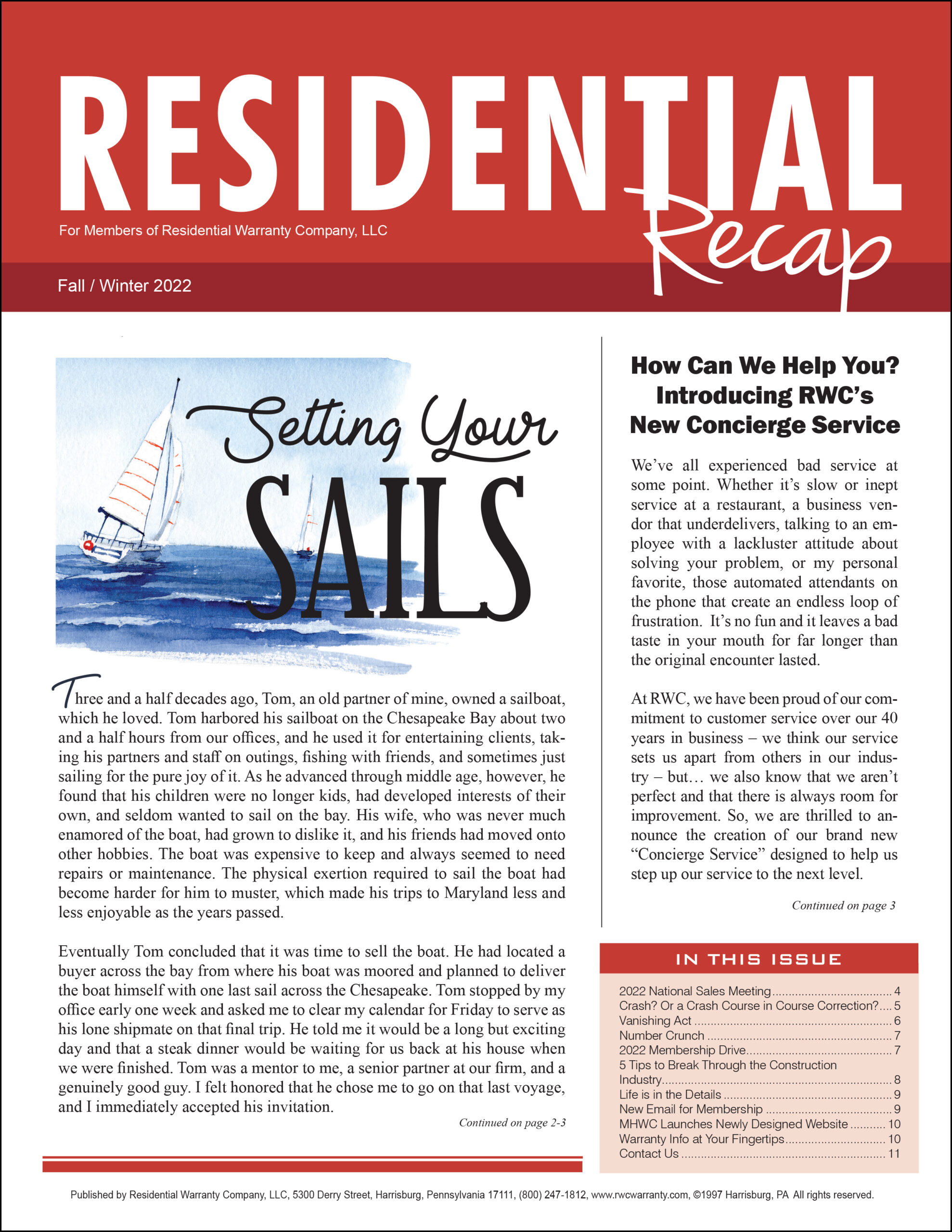Check out building / warranty / industry news, RWC announcements, upcoming events, etc.
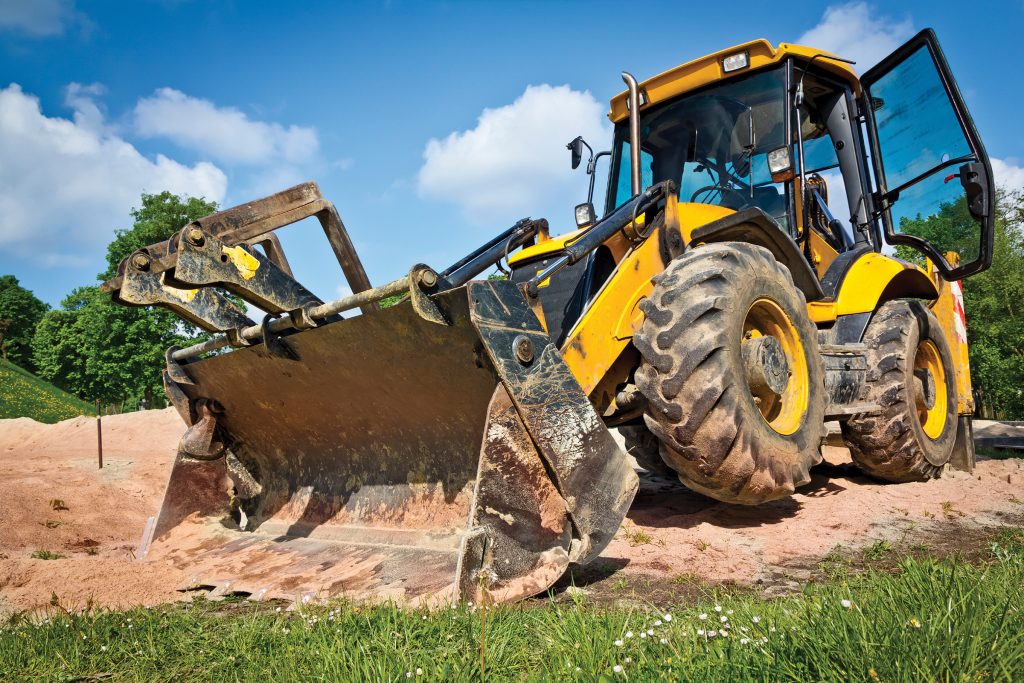 Did you know that there is a specially designated number you should call before starting any digging projects? 811 is the (free) phone number you need to call before digging to protect yourself and others from unintentionally hitting underground utility lines.
Did you know that there is a specially designated number you should call before starting any digging projects? 811 is the (free) phone number you need to call before digging to protect yourself and others from unintentionally hitting underground utility lines.
There are millions of miles of buried utilities beneath the surface of the earth that we don't even think about but are vital to everyday living like water, electricity and natural gas. By simply calling, you'll help prevent unintended consequences such as injury to you or your family, damage to your property, utility service outages to the entire neighborhood and potential fines and repair costs.
Most contractors know that they need to find out what’s underground before beginning to break ground, but there may be some finer points of safe digging that you’re not aware of.
How exactly does this 811 thing work?
Simply call 811 from anywhere in the country a few days prior to digging, and your call will be routed to your local call center. Tell the operator where you're planning to dig. Your affected local utility companies will be notified about your intent to dig and will send locators to your dig site to mark the approximate location of buried lines with flags or paint.
When can I begin my digging project?
Wait for the marks! Utilities will mark their buried lines on your dig site. Most crews will arrive to mark your dig site with paint or flags within a few days and will make sure you know where to avoid digging so you don't hit buried utilities. Remember there may be multiple utility lines in the same area. Be sure to check your state laws for specific information. It's also a good idea to call and confirm that all affected utility operators have responded to your request and located accurately. (State laws vary on the process for confirmation; check with your local one-call center for more information.)
It's finally time!
Now it's time to roll up your sleeves and get to work - but respect the marks! Make sure to always dig carefully around the marks, not on them. State laws generally prohibit the use of mechanized equipment within 18-24 inches of a marked utility, which is called the “tolerance zone”. If you must dig near the marks, hand dig or use vacuum excavation to expose the facility. After exposing the facility, avoid using mechanized equipment within the same tolerance zone.
The marks provided by the affected utility operators are your guide for the duration of your project. If you are unable to maintain the marks during your project, or the project will continue past your request’s expiration date, please call 811 to ask for a re-mark. In addition, if excavation equipment is removed from a work site for more than two (2) business days, you must notify the call center again.
Also keep in mind that some utility lines may be buried at a shallow depth, and an unintended shovel thrust can bring you right back to square one - facing potentially dangerous and/or costly consequences. Don't forget that erosion or root structure growth may shift the locations of your utility lines, so remember to call again each time you are planning a digging job. Safe digging is no accident!
Source: call811.com and ccicomply.net
[vc_row][vc_column][vc_column_text]www.nahb.org and www.newhomesource.com
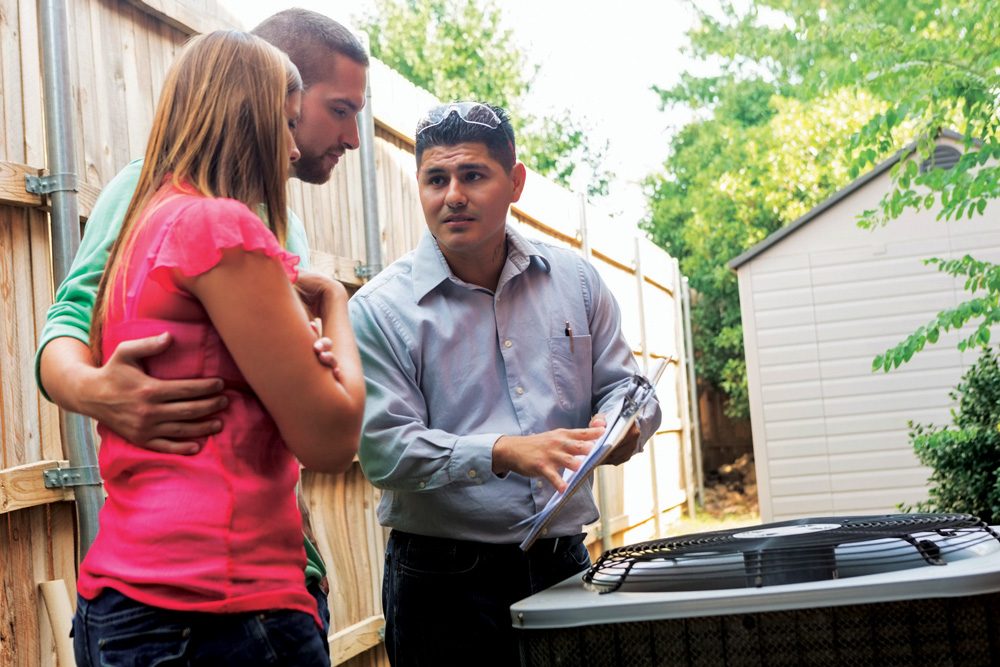 Before a homeowner goes to settlement on the purchase of a newly constructed home, you and the homebuyer should do a walk-through to conduct a final inspection. This walk-through will provide an opportunity to spot items which may need to be corrected or adjusted, educate the buyer about the way the new home works and what their responsibilities are, and answer any questions the homebuyer doesn't understand.
Before a homeowner goes to settlement on the purchase of a newly constructed home, you and the homebuyer should do a walk-through to conduct a final inspection. This walk-through will provide an opportunity to spot items which may need to be corrected or adjusted, educate the buyer about the way the new home works and what their responsibilities are, and answer any questions the homebuyer doesn't understand.
How Things Operate
When you buy a new appliance such as a washing machine, you usually have to read the instructions before you understand how to use all of the features. With a new house, the buyer will be overwhelmed with new appliances, systems, and maybe even ‘smart’ features. Not only will it help immensely if someone takes the time to show them how to operate all of these components and gadgets, but it shows that you care about the home and take pride in your finished craftmanship.
Maintenance Responsibilities
Part of your walk-through should be educating the buyer about maintenance and upkeep responsibilities. When you provide your buyers with a ten-year warranty, workmanship and materials are covered for one year. However, such warranties do not cover problems that develop because of failure to perform required maintenance. RWC/HOME of Texas provides a clearly written warranty booklet explaining what’s covered, what’s not covered, the responsibilities of new homeowners, and actions required citing specific guidelines and standards.
Builder Visits During the Year
Each builder is different, however, typically builders schedule two visits during the first year — one near the beginning and the other near the end — to make necessary adjustments and to perform work of a non-emergency nature. Explain to your client that you won’t be rushing out immediately for a problem such as a nail pop in your drywall. Such problems occur because of the natural settling of the house and are best addressed in one visit near the end of the first year.
Your Inspection Checklist
 Creating a checklist when inspecting the house is key to organization and cognizance. The list should include everything that needs attention, and you and the homebuyer should agree to a timetable for repairs. Explain to the buyer that it’s best to remedy problems before they move in, because it is easier to work in an empty house. However, some items may have to be corrected after move-in. For instance, if the walk-through is in the winter, landscaping adjustments may be delayed until spring.
Creating a checklist when inspecting the house is key to organization and cognizance. The list should include everything that needs attention, and you and the homebuyer should agree to a timetable for repairs. Explain to the buyer that it’s best to remedy problems before they move in, because it is easier to work in an empty house. However, some items may have to be corrected after move-in. For instance, if the walk-through is in the winter, landscaping adjustments may be delayed until spring.
It is important to be thorough and observant. Examine all surfaces of counters, fixtures, floors and walls for possible damage. Sometimes disputes arise because a buyer may discover a gouge in a countertop after move-in, and there is no way to prove whether it was caused by the builder's workers or the buyer's movers. Many builders ask their buyers to sign a form at the walk-through stating that all surfaces have been inspected and that there is no damage other than what has been noted on the walk-through checklist.
In preparation for the walk-through and to ensure everything goes smoothly and efficiently, educate your homebuyers with these walk-through “Dos and Don’ts”.
DO
- Make a list in advance of any questions about maintenance/warranty procedures.
- Bring pens, paper, a clipboard, digital camera or phone to take notes and photos.
- Bring the purchase agreement, RWC/HOME sample warranty book, customer service manual, selection sheets, diagrams and landscape and pool plans, if applicable.
- Wear clothing that is appropriate for walking a construction site, including closed-toe shoes.
- Park in the street, not the driveway, especially if the home is still under construction.
- Verify the expected dates for completion of repairs, if any are needed, and get a copy of the completed punch list before you leave the site.
DON’T
- Be late for the walkthrough. Builders have busy schedules and may have appointments with other customers on the same day.
- Bring pets, children or other family members and friends. You’ll need to devote your full attention to what is being presented.
- Rush through the walkthrough. Take your time and be thorough.
- Be shy about asking a lot of questions.
On that note, the homebuyer will most likely ask a lot of questions during the walk-through and take notes on the answers. Be patient. This is the dream home they’ve been anxiously waiting to move into for months and they want to make sure everything is up to par and in perfect working order. It is important to view the walk-through as a positive learning experience that will enhance the enjoyment of your client’s new home for years to come. And furthermore, a genuine, caring and thorough home builder will get all the praise and kudos through word of mouth - the most powerful (and free) form of advertising![/vc_column_text][/vc_column][/vc_row]

Due to advancements in technology and the increasing demand for affordable homes, modular construction continues to increase in popularity. In fact, modular home construction can often go toe-to-toe with, or in some cases even out-perform, site-built homes.
There are several benefits of modular construction for both the contractor and the homebuyer. Speed is a big factor. Since each phase of construction is carefully planned out, there are few last-minute problems or conflicts that will result in delays or plan revisions. Modular homes are typically built 33% faster with greater efficiency than a site-built home. Think about the countless individual pieces of material a site-built home needs from start to finish. Of course, the prefabrication phase uses many of these same materials, but once out of the factory, a modular home requires only connecting several large-scale components. At this point, delays including supply and delivery issues, are often kept to a minimum.
Prefabrication can also reduce the cost and time to build a home by a significant amount in several ways. First and foremost, factories are climate controlled, which means there are no weather-related construction delays adding time and money to the project. Secondly, there are also no cost over-runs from “no-show subs”. Subcontractors are already there in the factory, eliminating the need to find reliable skilled tradesmen. And third, materials are generally bought from suppliers through volume purchasing, thus getting better prices all the while controlling inventory with less waste.
Speaking of wasted materials, stick built homes tend to be less environmentally friendly than their modular counterpart. According to a National Association of Home Builders (NAHB) study, an estimated 8,000 pounds of waste is created from the construction of a 2,000 square foot home. The majority of that is wood, cardboard, and drywall and almost all of that waste ends up in landfills. Conversely, any extra materials or waste from a modular home is recycled.
There is however one thing that both modular and stick built homes have in common, and that is the need for a written insured new home warranty. As an RWC/HOME of Texas member, you know first-hand the benefits of providing a warranty on your homes. The construction industry comes in all shapes and sizes and so do warranties. Be sure to check out all of our risk management services and warranty products or call your Account Executive for more information.
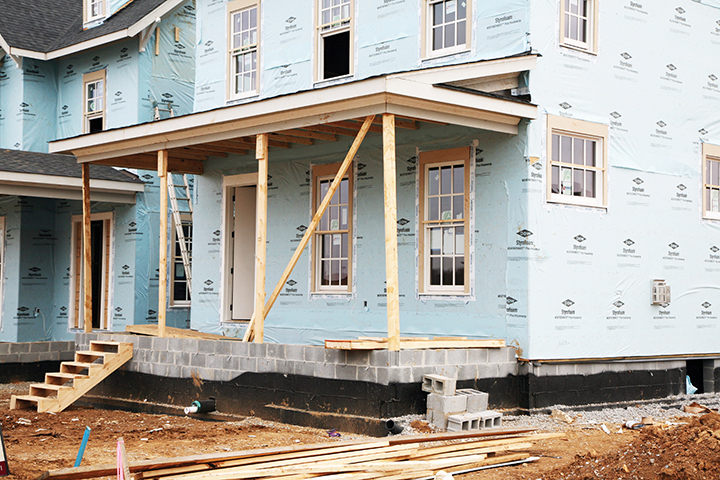 You and your crew have been working hard these past few months. In fact, you’re ahead of schedule. Then, you get a call from one of your jobsites. A woman tripped over a piece of scrap lumber and fell on the sidewalk in front of one of your nearly finished houses. None of your crew saw it happen since they were working inside. Your jobsite supervisor offered to call 911, but the lady seemed more embarrassed about what she described as her “accident proneness” and politely refused the offer. After that, she went on her way. No one bothered to get her name or contact information. You heave a sigh of relief and think all’s well that ends well. Still, you can’t shake the feeling; is there anything more you should have done?
You and your crew have been working hard these past few months. In fact, you’re ahead of schedule. Then, you get a call from one of your jobsites. A woman tripped over a piece of scrap lumber and fell on the sidewalk in front of one of your nearly finished houses. None of your crew saw it happen since they were working inside. Your jobsite supervisor offered to call 911, but the lady seemed more embarrassed about what she described as her “accident proneness” and politely refused the offer. After that, she went on her way. No one bothered to get her name or contact information. You heave a sigh of relief and think all’s well that ends well. Still, you can’t shake the feeling; is there anything more you should have done?
Unfortunately, there isn’t much you can do. What’s the use reporting that an unknown woman fell at one of your jobsites, refused medical attention and disappeared. However, that doesn’t mean this isn’t a Premises / Operations claim under your General Liability policy. Many injuries take time to manifest indications of how serious they really are. The person can be in mild shock and truly believe they aren’t hurt. As they begin feeling pain, sometimes days later, they go to the ER and file the claim under their medical insurance. The medical insurer discovers where the injury happened and eventually seeks reimbursement against your general liability company. Now you may have to explain why nothing was reported. This could impact your renewal pricing. If the claim spirals into a really large loss, you may even face nonrenewal.
All this can be avoided by establishing and following a simple procedure for dealing with incidents involving the public. Whether they happen to a person or their property, the following suggestions may serve as a general guideline to assist you in setting up an Incident Reporting Procedure:
As soon as you learn of any accident or incident involving the public find out if anyone is injured.
• If someone is hurt, call 911. Stay with the person until first responders arrive and follow any instructions they may give.
• Don’t move the person unless you have to in order to protect them from further injury.
• If you administer first aid, make sure you, or someone you know is competent to do so.
• Don’t admit guilt or accuse anyone.
• Your focus is to keep the injured person calm and make sure they get the emergency medical attention they need.
• If the person refuses medical aid, don’t try to force them. Try to get their name, phone number and address, but don’t insist if they prefer not to talk to you.
• If someone’s property has been damaged, call 911 if first responders are needed to prevent the accident from getting worse - such as a fire spreading.
• Try to get the names and contact information of any witnesses. Keep in mind these may include neighbors or passersby.
• Without putting yourself or others at risk, do what you reasonably can to prevent further injury to people or damage to property.
• Contact your general liability insurance company as soon as you can. Give them all the information you have gathered.
• Put your Incident Reporting Procedure in writing. Make sure everyone in your organization is aware of it. Review it often at periodic safety meetings.
To sum up, a premises/operations claim is a claim under general liability when a member of the public is injured or their property is damaged at any place related to your business over which you have direct, or indirect control.* The extent of injuries or damage may not be apparent at the time of the accident, but knowing as much as possible as soon as possible can be critically important when and if the accident develops into a claim.
WANT TO EARN UP TO 25% OFF YOUR GENERAL LIABILITY PREMIUM?
If you are insured with the RWC INSURANCE ADVANTAGE, having a written Incident Reporting Procedure as part of a formal safety program can qualify you for significant discounts.**
For more information, visit our website: rwcinsuranceadvantage.com. Or if you’d prefer speaking to one of our licensed agents, give us a call at 1-866-454-2155.
*This generally describes a claim for premises/operations third party liability damages. The various terms, conditions and exclusions in the General Liability Policy must be established to determine if a claim is, in fact, a covered loss.
**Discounts are subject to all other underwriting criteria and are not guaranteed.[/vc_column_text][/vc_column][/vc_row]

Do you know your Account Executive? Are you aware of everything that your Account Executive (A.E.) can do for you? If you answered no to either of these questions, it is time to get acquainted!
Each state is assigned a specific A.E. who is more than just a product salesperson. You may have only interacted with one another when you initially signed up to become a member. Since you may have discussed your initial enrollment process with them over the phone, it is not always easy to recall with whom you spoke. To find your specific representative, you can call into our main office at 800-247-1812 (Texas: 800-445-8173) to inquire or visit our website and click the "Find Your Account Executive" link within the Builder tab's drop-down menu.
Your A.E. serves as more than an initial contact to guide you through the process, they are also your liaison and program concierge. Their role is to help you develop a suitable program for your business. As a member, you have access to a full array of programs and options. For example, if you desire to obtain a quote for liability insurance, wish to offer appliances coverage, or need additional training set up for your team, your A.E. can make these arrangements.
As the end of the fiscal year approaches, common practice dictates that a performance evaluation analyzing the prior year will be completed. Ultimately, it is a time in which new methods or ideas may be slated for implementation with the intention of improving the overall corporate health. Setting aside time to review your warranty coverages and comparing how your business has developed or changed can be a vital part of this process, the purpose of which is to aid in ensuring that a thorough evaluation has been considered. Since businesses can fluctuate from year to year, RWC/HOME recognizes that your initial warranty options may no longer work as a ‘one-size-fits-all’ solution. This is where your Account Executive can work with you to develop the best plan which complements these fluctuations.
If the timing for this sort of evaluation is currently not quite appropriate, keep in mind that your A.E. will periodically be reaching out to you via phone, email, or mailings. However, you do not have to wait for them to contact you to initiate the line of communication. When something from RWC/HOME passes over your desk, let it serve as a reminder to get in touch. Once it is time to think through all the ways in which your business may have developed or changed after your initial enrollment, your A.E. is your best resource. Setting a meeting with your RWC/HOME Account Executive will allow you the opportunity to review each of the servicing options at your disposal. Of the tools in your arsenal, the relationship you develop with your representative is a key component. Remember that they are your partners, meant to serve as a support system for your company, now and into the future.
 Key Estates Warranty is a new affiliate of Residential Warranty Company, LLC, HOME of Texas and MHWC is now offering extended warranties for homes involved in real estate transactions across the country. Offered exclusively through a network of approved Real Estate Professionals, the Key Estates Warranty program provides extended warranty protection on a variety of appliances, systems and even structural components in existing homes.
Key Estates Warranty is a new affiliate of Residential Warranty Company, LLC, HOME of Texas and MHWC is now offering extended warranties for homes involved in real estate transactions across the country. Offered exclusively through a network of approved Real Estate Professionals, the Key Estates Warranty program provides extended warranty protection on a variety of appliances, systems and even structural components in existing homes.
Homeowners understand that eventually, most things break down. Extended warranties are a cost-effective way to deal with expensive and unexpected repair bills after moving into a newly purchased home. The package approach of Key Estates provides the homebuyer with the security of more comprehensive coverage but at a substantially lower rate than if they were to buy individual extended warranties on each item of equipment. Through Key Estates, homeowners are protected against potential financial burdens for one or two-year terms on covered items. Without an extended warranty, homeowners may have to pay hundreds – or even thousands - of dollars for repairs. With Key Estates, homeowners are responsible for only a small service fee.
Key Estates personnel will conduct a remote visual inspection of the appliances and mechanical systems that are eligible for coverage. We will visually inspect photos /videos of the appliances for “trouble spots” that could indicate an imminent failure and search for recall notices. When the appliances pass the inspection, Key Estates certifies the home as warrantable and an insurance backed warranty is issued. This certification should add an additional layer of peace of mind for everyone involved in the transaction.
Major Structural Defect Coverage
With the average cost of major structural defect repairs in this country exceeding $35,000, Key Estates offers valuable protection from financial disaster should a structural defect develop in their existing home. Under Key Estates, a homebuyer may opt for major structural defect coverage – similar to the coverage provided to new home builders under our 10-year warranty plans – to be added to their plan for 1 or 2 years. No other resale warranty plan in the country offers this type of tried and true structural protection on existing homes! In addition, a structural home inspection conducted by a professional, licensed engineer, is part of the requirement to verify the structural ‘health’ of the home. This optional structural coverage is available everywhere except for Colorado and certain areas in Texas that have been designated as active soils areas.
Flexibility & Control
In addition to the never before offered structural coverage on existing homes, setting this program apart from others is the level of flexibility built into our system. Homeowners have the freedom to choose their own repair provider when a covered appliance or system breaks down. Additionally, they can select optional coverage for many of the ‘extras’ such as swimming pools, spas, freezers, etc. to further customize their plan.
Benefits
Real Estate Professionals benefit from Key Estates in a variety of ways. Exposure to customer service issues is dramatically reduced since the Key Estates’ administrator takes over complaint handling for problems with covered appliances, systems, and structural components. An administrative fee may be paid to the real estate professional for every warranty sold, generating extra revenue to make the program profitable and benefit that important bottom line. Ultimately, Key Estates provides a unique marketing tool that will set the Real Estate Professional apart from the competition.
Contact Us
For availability and more information about Key Estates or any of the other plans RWC and Affiliates have to offer, go to www.KeyEstatesWarranty.com, call 866-394-5135 ext. 2149 or email us at Sales@KeyEstatesWarranty.com.
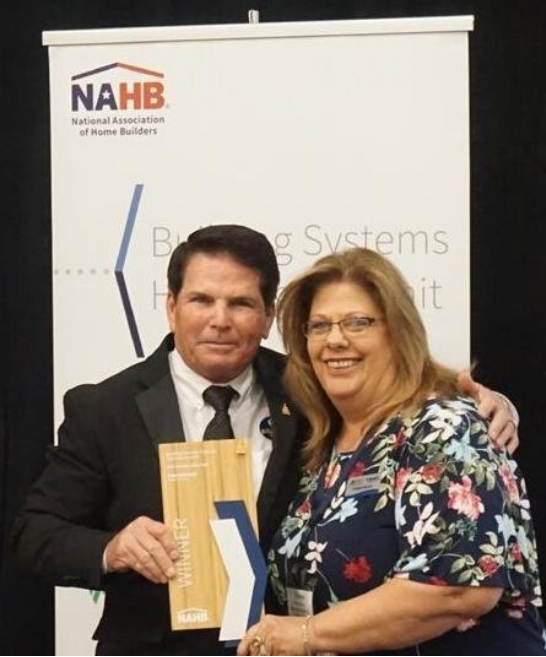 The Building Systems Council (BSC) Specialty Awards recognize one BSC builder, manufacturer, associate, and young professional for their contributions to the council, NAHB and the housing industry along with their involvement with civic or charitable organizations. Award winners demonstrate excellent business practices while providing outstanding service to his/her customers.
The Building Systems Council (BSC) Specialty Awards recognize one BSC builder, manufacturer, associate, and young professional for their contributions to the council, NAHB and the housing industry along with their involvement with civic or charitable organizations. Award winners demonstrate excellent business practices while providing outstanding service to his/her customers.
This year, one associate council member has stood tall amongst the rest. The winner of the 2018 Building Systems Councils Associate of the Year is Tifanee McCall of RWC/MHWC. Daniel Mitchell, Owner Eagle CDI, Inc. and Vice Chairman of NAHB's Custom Home Builders Committee presented Tifanee (pictured right) with her award at the recent NAHB Building Systems Summit in Knoxville, TN. Tifanee has been a BSC member for over a decade and currently serves as the council's second vice chairman and chairman of the membership and communications subcommittee. Kudos, Tifanee!
 Warranties come in all shapes and sizes and if you are looking for something besides the "traditional" new home warranty, RWC's Customized State Warranty (CSW)* is the answer! This warranty is the most unique and specialized new home warranty program in the industry. Each customized warranty is crafted specifically to meet each state’s statutes regarding new home warranties. The Builder’s liability is limited and individual state requirements for coverage are included, as applicable. RWC’s insurer covers warranted structural failures from day 1 throughout the entire warranty term.
Warranties come in all shapes and sizes and if you are looking for something besides the "traditional" new home warranty, RWC's Customized State Warranty (CSW)* is the answer! This warranty is the most unique and specialized new home warranty program in the industry. Each customized warranty is crafted specifically to meet each state’s statutes regarding new home warranties. The Builder’s liability is limited and individual state requirements for coverage are included, as applicable. RWC’s insurer covers warranted structural failures from day 1 throughout the entire warranty term.
For more information visit rwclive.wpengine.com and click "Warranties - State by State" under the Builder tab. You may also email sales@rwcwarranty.com or call 800-247-1812 x2149.
*Not available in AK, CO, HI, NJ & TX
Why do bad things seem to happen most on Monday mornings? We even call it “Blue Monday.” Take the builder, for example, who wasn’t named Additional Insured on his exterior painter’s general liability policy.
Our builder came to work one fine Monday morning to discover a voice-mail. His painter had over-sprayed a dozen parked cars in a lot across the street from his three-story townhouse project that was nearing completion. It happened on Saturday, which was windy. Too windy for spray painting three floors up. The cars belong to a pre-owned Corvette dealership. Each Corvette is worth an average $40,000. The estimated cost to re-paint all twelve is over $104,000. The painter admitted he’d messed up big time and lamely explained rain was forecast for the next four days, so he decided to “make hay while the sun shined.”
Our builder’s subcontractor was obviously at fault. Our builder had no part in this loss. When he hired the painter he expected he was dealing with a professional who knew his job. Yet our builder’s general liability policy, not the painter’s, is going to pay the claim. Our builder’s insurance company, not the painter’s, is going to defend him in the lawsuit soon to be filed by the Corvette dealership. They are claiming loss of market value now that they have to disclose to customers that their inventory had been damaged. This is going to get ugly and consume large amounts of our builder’s time. His insurance company may not renew his policy. Why? Simply because our builder was not named Additional Insured on the painter’s policy. So, what’s so important about being named Additional Insured anyway?
When you require your subcontractors to list you as Additional Insured on their general liability policies, you become entitled to insurance coverage benefits under their policies. Additional Insured status is most often used in connection with an indemnification agreement, also known as a hold-harmless clause. Hold harmless clauses are common in properly executed contracts between you and your subcontractors.* Under a hold-harmless, your subcontractors agree not to hold you responsible for their negligent acts which may happen while they are working for you. Without you being Additional Insured on your subcontractors’ policies, you can be brought into any suit resulting from your subcontractors’ negligent acts. Without a contract clearly holding you harmless, your general liability insurance company may have to cover the loss and defend you if you are sued. They may seek reimbursement from your subcontractors’ insurance companies, or the subcontractors themselves. Your insurance premium could increase due to the greater exposure, or your insurance company may even decide to not renew your coverage.
Additional Insureds! Hold-harmless clauses! Contracts! Maybe every day is Blue Monday when you have to deal with such things. Consider this, however; why jeopardize your insurance coverage because an incompetent painter decided to use a spray gun on a windy day?
The RWC Insurance Advantage is committed to providing you with the best possible general liability insurance protection. But, we need your help. Here’s a checklist:
(1) Review your contracts with all your subcontractors.*
(2) Are you named Additional Insured on all their general liability policies?
(3) Do they all hold you harmless for all claims while working for you?
(4) Do you obtain up-to-date certificates of insurance every year from each one?
If you have questions about this article or would like us to review your general liability insurance needs, we’d like to hear from you. Contact us by email or call us at: info@rwcinsuranceadvantage.com or 866-454-2155
Make Blue Monday a little less blue.
*Please consider consulting an attorney if you need assistance in drafting contract language. This article is intended to help you better understand general liability insurance terms and coverages. It is not to be construed as legal advice. Terms and conditions of various insurance company policy forms may vary.

